The Character of Cricket Read online
Page 14
Some of Derby’s problems may stem from it not being a cricket town, but that in itself is a chicken and egg situation. It’s not just that the facilities have been so poor – the cricket has often seemed pawky and they have won fewer pots than most. Their most recent success was the NatWest trophy in 1981, and they did manage a championship in 1936. The photograph of the winning team hangs in the new pavilion and was explained to me by a steward who remembered watching them.
I quickly saw what Mr Pearman meant about Derby being a football town: ‘Jack Bennett,’ said my friend. ‘He was the trainer with Coventry City. Harry Storer – he played for Derby County and was Manager of Derby County and Coventry City.’ Their footballing prowess was as important as their cricketing skill. The captain was A.W. Richardson, ‘owner of a family business in Derby’. Then there was Alf Pope, and Harry Elliott and Bill Copson and Tommy Mitchell. My informant punctuated his rather lugubrious litany with: ‘He’s passed on’ or ‘He’s still knocking around.’ I have to confess the names meant very little to me and when I checked to see what Christopher Martin-Jenkins said of them in the Wisden Book of Cricket, I was not surprised to find such phrases as ‘hard-headed, efficient cricketers’ and that back-handed catch-all, ‘considerable character’.
Not that Derby doesn’t excite enthusiasm and even passion. A few months before visiting the ground I had been at Eyam, the famous Derbyshire plague village which had gone into voluntary isolation when the disease spread there in the seventeenth century from London. There in the churchyard was the grave of Harry Bagshaw, a Derby all-rounder from 1887 to 1902. He subsequently became an umpire. The tombstone shows an umpire’s hand signalling ‘Out’ as Bagshaw’s wicket goes down for the very last time. What I had not realised until reading it in the county yearbook was that Bagshaw was buried in an umpire’s coat with six pebbles in one pocket. He was holding a cricket ball in one hand.
They have had some famous players, too, including exiles from the north like Barry Wood and John Hampshire, and from further afield. Eddie Barlow, the South African, captained them from 1976-78. While I was there the best-known Derby player was the lissom Michael Holding, pitted this time against his fellow West Indian exile, Joel Garner of Somerset. (Play started late, after lunch, and Derby were quickly in trouble against the ‘Big Bird’ in the damp.) Perhaps Derby’s most famous captain was the Australian ‘Demon’, F.R. Spofforth, who married a girl from Birdsall. Unfortunately Spofforth captained them in 1890, after they had been deprived of first-class status for losing too many games. It was Spofforth who discovered that the assistant secretary, Samuel Richardson, had absconded with most of the club’s cash. Richardson, a former captain of the club, fled to Spain, where he changed his name and became official tailor to the Court of King Alfonso.
They have home-grown stars, too. Geoff Miller, their England all-rounder, was born in Chesterfield, and Bob Taylor, who holds the world record for dismissals by a wicket-keeper, is from Staffordshire, which is the next best thing. He had 1,471 catches and 175 stumpings. Over the years there has been a profitable association with the local public school, Repton, although the abolition of the amateur-professional distinction in 1963 has diminished its importance. Nine Repton blues played for the county and the side has also included Repton schoolmasters like J.D. Eggar. Two Reptonians have captained Derbyshire – D.B. Carr, now secretary of the Test and County Cricket Cricket Board, and G.L. Willatt. I was reminded of this on encountering Mr Willatt, my reader, as we both walked the perimeter of the racecourse ground.
He was standing by the sightscreen, and as we looked out at the modest gables of the new pavilion and the little spring onion cupola on the grandstand, he told me how he came to Derby. At Cambridge, where he was captain, he played vacation cricket for Notts; then he became a schoolmaster and played no first-class cricket for a while until Derbyshire and Repton cobbled together a remarkable deal. The convention in those days – the fifties – was still that counties were captained by an amateur. Derby invited Willatt to take the job. Repton were anxious to engage him as a schoolmaster and also made an approach. Repton, however, were not keen to take him on for only two terms a year while he played cricket all summer, and certainly weren’t prepared to pay him in absentia. Derby couldn’t pay him, because if they did he would have lost his amateur status. So it was agreed that Repton paid him for the autumn and spring terms; then he left to play cricket. Repton continued to pay him but were reimbursed by the county cricket club, who paid the school to hire a temporary replacement. Thus was the myth of the amateur skipper preserved!
Times were changing even then. ‘There was an old wooden pavilion then,’ he told me (wicket and ground were then in a different position, even further away from the old grandstand), ‘and there was one big dressing-room for the amateurs and one much smaller one for the pros, of whom, of course, there were many more. I insisted on the same dressing-room for everyone. My chairman was horrified.’
It must have been a grim, windswept place. The players sat in the starter’s box; there wasn’t even a white boundary fence until 1980. There is now a mound and trees to give some shelter, but it used to be one of the bleakest grounds in the country as well as one of the biggest. In fact, although it may not actually be, it feels like the biggest county ground in England.
It is never going to be cosy, whatever they do with it, but I like the atmosphere. I liked the banter among the old sweats with the public address system up in the starter’s box. Mr Pearman, over a beer in the pavilion, said in the prescribed chief executive’s manner, ‘We’re still lacking facilities for the ordinary punter.’ I suppose he’s right, but they have cricket and you can see the medieval tower of the quasi-cathedral; and the Grandstand Hotel, the pub under the stand, at the far end away from the new pavilion, does good food and a decent pint, and the ordinary punters in there, waiting for Joel Garner to have a go at the young Derby batsmen, seemed to be happy enough. One ordinary punter who had kept his hat on and was wearing his tie outside the pullover under his jacket was holding forth to all and sundry the way ordinary punters do. ”E is a good bat,’ he said, splashing the beer from his straight-sided glass as he waved it about. ‘’E is a good bat. I’ve seen ’im opening for Second XI. But it’s bloody bowlers we want, not bloody batsmen.’
And when he had finished another ordinary punter regarded him thoughtfully and said, ‘’Ave yer done?’
That day’s Derby Evening Telegraph had a headline over the cricket report which said, ‘No Miracle for Derbyshire this time round’, and I wouldn’t expect many real miracles this time round, nor for a few rounds yet. At the same time I’d as soon be in Derby on a summer cricket day, however grey, than in a few more widely touted spots. But perhaps that is just because it was the only county ground in England where I met a committee member who had read one of my books.
The St Lawrence Ground, Canterbury
The 1985 Australian tourists were not one of the great cricket teams, but there were times when they looked the part. At Canterbury on a pleasant shirt-sleeve order day Border and Ritchie whacked some very ordinary Kent bowling to all corners of the field. One lofted drive of Ritchie’s smashed straight through the windscreen of a yellow Volkswagen which had parked culpably close to the long-on boundary. Serve the owner right, I thought. Present a glass front to a batsman like that, especially when he is facing bowlers like them, and you are asking for trouble.
1 felt a certain more general satisfaction over the incident because Canterbury is one of those grounds that everyone enthuses about, like Arundel or Worcester. And yet aesthetically it is spoiled if not ruined by allowing cars to park around much of the perimeter just over the boundary fence. Yes, yes, there is a funny old pavilion and the eccentric tree on the field of play and the famous memorials to Blythe and Fuller Pilch, and yet, on a busy day like the one I was there, it’s a little like watching a game of cricket in the middle of the Motor Show.
It does something else, too. At grounds like Chelmsfo
rd, say, or Lord’s, where there are seats all the way round and no room for a parked car with a view, the watchers congregate in particular favoured spots. A regular crew of cronies always gravitates to the Long Room or the Tavern, and once there swaps audible anecdote and passes knowledgeable comment. It creates atmosphere.
At Canterbury, however, I felt as if I was at a point-to-point. Instead of congregating in sociable groups, spectators sat beside their Range Rovers with their wives and their labradors drinking gin and tonic from small plastic glasses and minding their own business. They came with their own fold-up chairs and their own picnics, and I was told by the man on the gate that before a big game there is an astounding ritual, like the start of a Silverstone Grand Prix, as members queue up for the best parking lots and then barge in when the gates open just like Ayrton Senna and Alain Prost jockeying for position on the first bend.
So I felt there was some justice in the smashed windscreen; however, there was compensation, and because this was cricket the compensation was rather charmingly organised. The ball was autographed by Ritchie and presented to the car’s owner as a souvenir of the occasion. Very British.
I went on the August Bank Holiday, and it was noticeable that this was a holiday occasion in a new and rather saddening sense: at the Nackington Road end there is an old iron stand, built in the late 1850s and now given a plate glass face-lift in order to accommodate sixteen executive boxes. It is named after Leslie Ames, one of that great line of Kentish wicketkeeper-batsmen, and on August Bank Holiday it was virtually empty. No dark suits. No business lunch. I can only suppose they were all off playing golf. Clearly there is no demand for an executive cricket-watching facility on a bank holiday. There is obviously no point in inviting businessmen to the cricket unless it gives them an excuse to get out of the office.
Otherwise it was a good crowd. Despite the threat of impending rail strike the train was full of tourists and trippers heading for the Kent coast. From the window you could see apples and hops and oasthouses and the cathedral at Rochester. Canterbury’s cathedral is older and grander, of course, but the cricket ground is out on the Old Dover Road, away from the city centre. The quickest way is to turn right out of the station and walk along the ring road, but that is deadly dull and it doesn’t take much longer to cross over and walk the old city wall as far as a roundabout, where you cut off and walk past Oaten Hill and Nunnery Fields and realise you are getting warm when you reach the Bat and Ball pub and Cowdrey Place.
The ground is at its absolute best during the famous cricket week, when there are tents and bunting and bands. There is still an office at Canterbury called ‘The Week Office’, the name dating from the days when the county was itinerant and had a series of offices wherever they played one of their ‘weeks’. Nowadays it is the home of the public address system.
The first thing a visitor should do is to turn left inside the ground and pay his or her respects at the two memorials. One is to Colin Blythe and the other to Fuller Pilch. Pilch’s used to be in St Stephen’s Church and has a wonderfully stiff upper lip sort of inscription which says: ‘This monument is erected to the memory of Fuller Pilch by upwards of two hundred friends to mark their admiration of his skill as a cricketer and his worth as a man.’ It adds that from 1836 to 1854 he was ‘the best batsman known to cricket before the advent of W.G. Grace’. From 1847 to 1862 he was the Kent groundsman. He batted in a black top hat, was landlord of the Saracen’s Head, and his snuff-box is in the pavilion.
There was a sad bunch of carnations at the foot of Blythe’s memorial which says that he was ‘unsurpassed among the famous bowlers of the period and beloved by his fellow cricketers’. In the fifteen years before the Great War he took 2,210 wickets at under seventeen apiece. The Blythe pavilion memento is more macabre. It is his wallet, shredded by the shrapnel which killed him at Ypres in 1917. He was just thirty-eight years old.
They are keen on their history at Canterbury and, thanks to their two honorary curators, E.W. Swanton and Chris Taylor (who can usually be found in the ‘Week Office’), they have a photograph on the dining-room wall of every man who has won his county cap. Chris, who has been watching cricket at Canterbury since 1928 when he was eight years old, prides himself on having a newly capped player’s picture on the wall almost as soon as the captain has presented him with his hat. For this Australian match a seriously depleted side were obliged to field their cricket manager and former player, Brian Luckhurst. Luckhurst was supposed to have retired almost ten years earlier but already Chris Taylor had amended the dates to take account of this unexpected curtain call. ‘Career under review’ it said under his picture.
The ground’s most famous feature is the tree, though not everyone seems to realise this. The artist commissioned to paint a picture of the ground for ‘Project ’85’, which involves the building of the first brand new stand since 1926, managed to put the celebrated lime behind the boundary and off the field of play. Presumably when he got home and looked at his sketches he assumed that he had been hallucinating. After the limited edition of prints had been produced the tree was repainted on each one by hand!
The consensus is that the tree is a lime and about two hundred years old. The tree surgeons apparently say that it is good for another seventy, but if it did have to be felled you can bet your life the Kent marketing experts would make the most of it. The ‘Project ’85’ leaflet carries an announcement about the tree which so perfectly captures one facet of modern county cricket that I feel it is worth reproducing virtually in full. It comes under a small drawing of the tree together with another of a bat and wicket in a glass case, and it reads thus:
‘There is only one tree in the world that is within the boundary of a first-class cricket ground. Yes, you’re right – the famous lime tree at the St Lawrence Ground, Canterbury. Loved by generations, this common lime has presided over some 200 years of cricketing history. Now you can own a piece of this famous tree. For Project ’85 the Kent County Cricket Club has arranged for a small number of miniature sets of stumps, bails and bats to be made from boughs of the St Lawrence lime, which were saved when the tree was pollarded in 1980.
‘Each commemorative set will be hand made, numbered and mounted under a protective glass covering. For just £260 you can own a piece of unique cricketing history. To reserve your set apply to: the Secretary, Kent County Cricket Club, St Lawrence Ground, Canterbury, Kent, England, enclosing your cheque.’
I suppose I am prissy to be depressed by this and to find my only marginal consolation in the fact that the souvenir is not described as ‘prestigious’. The new stand should provide additional income of £50,000 a year, much of it from the new ‘Executive Club with viewing balcony’.
This is hard lines on the tree which deserves – I feel – a more romantic fate. On the morning I went to Canterbury The Times printed a photograph of Alan Border leaning against the tree while allegedly fielding. He looked quite pastoral. I was also told that Kent members are entitled, after cremation, to be scattered around the tree. After rain or a heavy dew the grass thereabouts is alleged to be a quite different colour, and the St Lawrence Ground joke is that these are the only non-combatants allowed on to the field of play actually during a match.
You can still see the cathedral from the boundary near the tree, although this is something which old stagers had told me was no longer possible. Certainly the cathedral in no sense dominates or even overlooks the ground. Canterbury is one of those places where the most important features are the pavilion and stands themselves. Those and the cars.
The cricketer that senior Kentings like Chris Taylor remember with the greatest awe is nearly always Frank Woolley. It seems sad that such an elegant carefree batsman should be commemorated with such a prosaic grandstand. ‘He could play fast bowling with a walking stick,’ said Mr Taylor, recalling Woolley against Larwood and Voce. According to the honorary curator, Woolley’s greatest virtue (though statistically his greatest vice) was his habit of getting out in the ni
neties.
Nevertheless, apart from the war years, Woolley scored over a thousand runs for Kent every year from 1907 until 1935. He caught 773 catches, too, as well as taking 1,680 wickets. In youth and age Woolley always managed to look stylish and quixotic. ‘Easy to watch, difficult to bowl to, and impossible to write about’ was R. C. Robertson-Glasgow’s pithy verdict. He hit his highest Kent score, 270, on the St Lawrence Ground against Middlesex in 1923, but the achievements I would most like to have witnessed took place elsewhere. In 1909, the year he first played for England, he and Arthur Fielder put on 235 for the last wicket against Worcester. They put on the first 119 in the last hour of the second day and 116 in the first hour of the third. When they started they were forty short of Worcester’s 360. When they had finished they were so far ahead they went on to win by an innings. Four years later he and Colin Blythe bowled Warwickshire out for 16 in forty-three minutes. They both took five for eight.
Kent is a grand cricketing county, replete with history and great names. Five Kent cricketers have captained England: I saw one of them, Mike Denness, wandering rather diffidently round the outfield. The earliest of his predecessors was Lord Harris, a much more ebullient figure, even though Denness had a higher batting average. There is a wonderful picture of Lord Harris taking strike, which I particularly enjoyed because there had been a lot of frothing on the part of the tetchier older guard of cricket writers and supporters about cricketers’ kits. The general drift was that it was deeply shocking that modern cricketers didn’t wear the proper county cap. The retired major school of thought took great exception to these damned floppy white sun-hat things Clive Lloyd brought over from the Caribbean. Yet here was Lord Harris, circa 1880, wearing just such a hat with a snap brim and a pale blue ribbon, together with a bow tie, a fine moustache and an expression of infinite superiority. Best of all, he is holding his bat about two feet off the ground in much the way that Graham Gooch waits for the bowler. That too aroused great ire among the purists, who thought it new-fangled. Some cricket ‘purists’ would think lob bowling new-fangled.

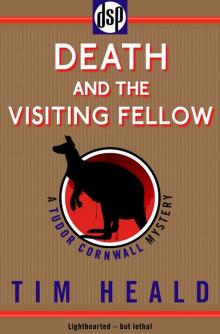 Death and the Visiting Fellow
Death and the Visiting Fellow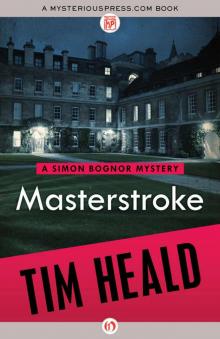 Masterstroke (The Simon Bognor Mysteries)
Masterstroke (The Simon Bognor Mysteries) Deadline (The Simon Bognor Mysteries)
Deadline (The Simon Bognor Mysteries)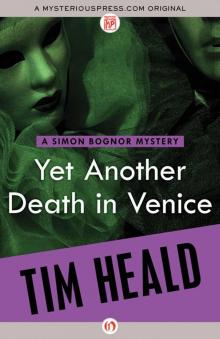 Yet Another Death in Venice (The Simon Bognor Mysteries)
Yet Another Death in Venice (The Simon Bognor Mysteries) Just Desserts (The Simon Bognor Mysteries)
Just Desserts (The Simon Bognor Mysteries) Let Sleeping Dogs Die (The Simon Bognor Mysteries)
Let Sleeping Dogs Die (The Simon Bognor Mysteries)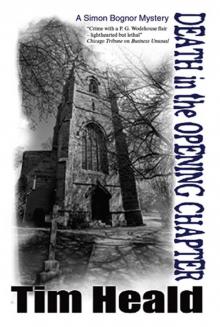 Death in the Opening Chapter
Death in the Opening Chapter Blue Blood Will Out (The Simon Bognor Mysteries)
Blue Blood Will Out (The Simon Bognor Mysteries)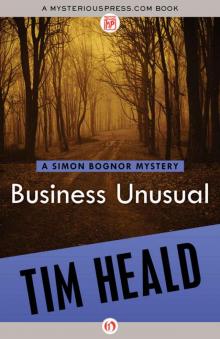 Business Unusual (The Simon Bognor Mysteries)
Business Unusual (The Simon Bognor Mysteries)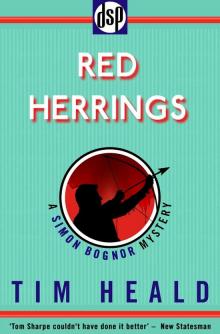 Red Herrings
Red Herrings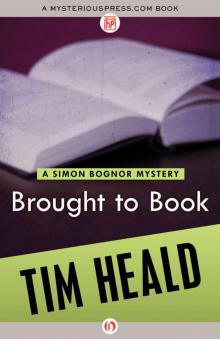 Brought to Book (The Simon Bognor Mysteries)
Brought to Book (The Simon Bognor Mysteries)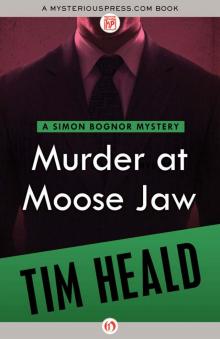 Murder at Moose Jaw (The Simon Bognor Mysteries)
Murder at Moose Jaw (The Simon Bognor Mysteries)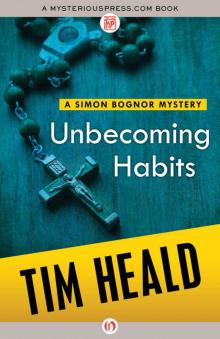 Unbecoming Habits (The Simon Bognor Mysteries Book 1)
Unbecoming Habits (The Simon Bognor Mysteries Book 1)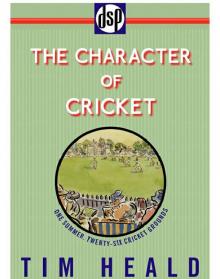 The Character of Cricket
The Character of Cricket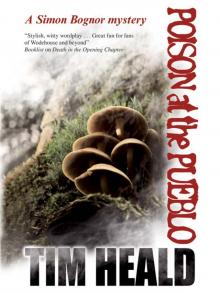 Poison At The Pueblo
Poison At The Pueblo A Death on the Ocean Wave
A Death on the Ocean Wave